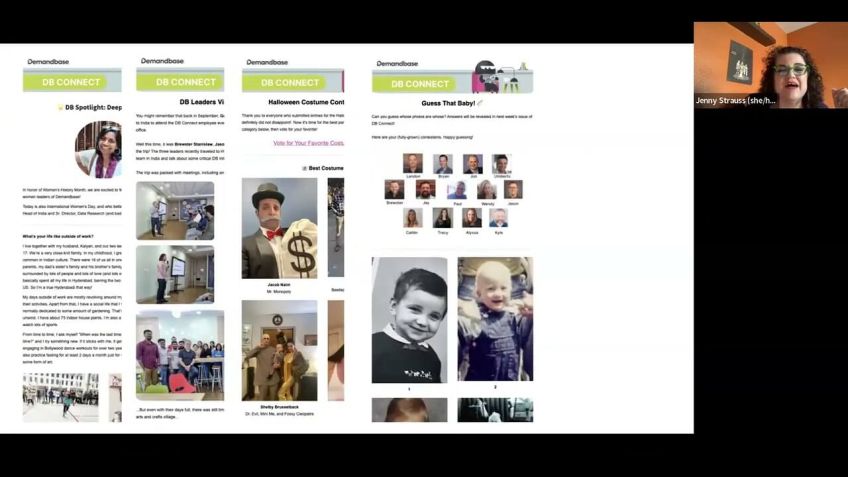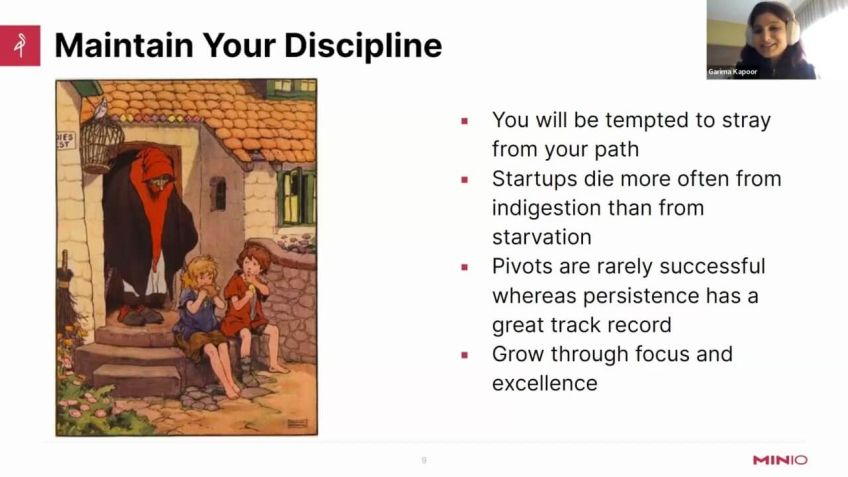How a people-first product leads to better work/life balance by Vrushali Patil Kaitlin Fink
Adapting to Pandemic-Induced Changes at Work: The Experience at Front
Good afternoon everyone. I want to kick-start this discussion with a provocative question: What is the one work value you rely on the most? Feel free to share your thoughts as you read through this piece.
The Essence of Front
Let me offer you a brief introduction to our company, Front, a customer communication hub aimed at building strong customer relationships. We serve over 7,500 clients from 98 countries, fundamentally disrupting technology sectors like email and customer support software. Beyond our product, we are a rapidly growing team, passionate about creating an environment that fosters happiness and productivity.
The Role of Our Values in Decision Making
At Front, our values of low ego, transparency, high standards, care, and collaboration guide our every action. Here's how:
1. Transparency: This core value helps us in harboring healthy debates and making informed decisions. We are committed to discussing ideas openly and leaving every meeting room with a decisive plan.
2. Low Ego: Our company nurtures a culture of retrospection. From our CEO to our team members, we regularly hold retrospections to assess our performances and identify areas of improvement.
Upholding High Standards in Product Development
We always aim for the highest standard in product development by focusing on our customer's needs and building empathy. We ensure our entire team has a deep understanding of our product and our customers’ journey using Front.
Making Employee Well-being a Priority
Front adopts the Flex-Friday policy emphasizing work-life balance. This allows our employees to decide how they want to spend their Fridays, contributing to their leisure and well-being.
Navigating Work Asynchronously with Global Teams
Working asynchronically while maintaining a sense of team belonging is paramount to global companies like ours. We have established time slots for meetings trying to bridge our geographical differences and time zone challenges and use dedicated means of communication for different purposes.
Conclusion
At Front, our ultimate mission is to make work happier by enabling better relationships at scale. Our commitment to our core values and our deliberate choice of tools all align with this mission. The steps we take to ensure transparency, uphold high standards, care for our employees, and foster collaboration ultimately contribute to our goal of building a happier and healthier working environment.
As leaders, we aim to take these principles and lessons we have learned from our experience and share them in the hope that they can be beneficial to your workplaces and teams.
Video Transcription
All right. I guess we can get going.
Perfect. Let's do it. Good
afternoon, everyone. Um I want to start today's presentation with one question for all of you. Every company has values. What is the one value that you use the most at work? Feel free to drop it in chat and while you're doing that, um I want to talk to you about uh how at front, we have adapted to the change that has come about because of the pandemic, which fundamentally changed our approach to work. We want to talk about how at front we rely on our values and our people to make that happen. But before we begin, I would love to introduce ourselves. Uh Caitlyn, why don't you go first?
Sure. Thanks for Charlie. I'm Caitlyn Fink, a product design manager here at front. And for those of you who don't know, front is a customer communication hub for building strong customer relationships. So today, our product is used by over 7500 customers in over 98 countries and millions of customers are served by teams using Front front is disrupting technology sectors that haven't been shaken up in a long time. So you could think email and customer support software. I believe we're at the early stages of our growth and we have huge potential for the market we can capture and that's one of the main drivers as to why I joined front, the design team, like many others here at front are growing quickly and I was excited by the opportunity to be intentional in our growth and ensure that we're creating an environment that helps our employees work happier as we continue to scale.
I was also immediately drawn to our Ceo Mathilde and her leadership style. She leads with transparency and is authentic to herself, two things that I strive for as a leader myself. And for the first time in my career, I'm proud to say that my CEO is a female, but even beyond that, 80% of our executive team is women and over 50% of our managers, even more reasons why a new front was the right place for me. So I'll pass it back to Virelli to introduce herself.
Thanks Caitlyn. So I joined front around the same time as Caitlyn. Um I joined as head of platform and I came from sales force where I was running engineering for a product called Salesforce Communities. I was there since the inception of the product. And by the time I left, we had close to 100 and 50 engineers on the team and uh hundreds of millions in revenue it was quite right. But I, I was looking for a change after 14 years. And uh for me, I wanted to work at a well run start up people and culture have always been very important. And so all this was true about front. But what was more important was the mission of the company, the mission to make work happier by enabling better relationships at scale. Um uh So let's go into what topics we plan to cover today. So there we go with three topics. One is how we drive alignment, two, how all this translates into the well being of our employees. And three, how do we support as leaders, our teams to work as synchronously without still losing that sense of belonging. So, uh Caitlyn and I have both referred to our values a few times. I want to elaborate what those values are. So we have five core company values, low ego, transparency, high standards, care and collaboration. All through the talk.
We'll be referring to these values and we'll be giving you concrete examples of how we put these values into action. So let's dive in. So how one day before it, I'm sorry. Um So how do we use our company values and our product to drive better decision making, to listen to our customers and to work efficiently. It really helps to have transparency as one of your core values because then people are not afraid to have a healthy debate when we need to make decisions, we get into a room, whether that's virtual or physical and we speak our minds, we duke it out, but we leave the room with a decision and that really helps us be efficient.
It also helps us come up with more creative and innovative solutions. And I'm sure you might have experienced that you're in meetings where you feel you have alignment. But after the fact, you realize that people actually weren't happy with the decisions made, but they couldn't be transparent.
And as a result, there is still dissent in the decision that was made and that is something we really want to avoid at front. Secondly, we have a culture of doing retrospectives at our company. So with low ego being our, our second uh core principle, we have a culture where we're not afraid to admit to our mistakes and learn from them as a company, we move fast so we can make mistakes. But the point is that we need to learn from them and move forward. And this goes all the way from our ceo Matilde who does these last year at front sessions where very candidly, she talks about what's gone well, what's not gone well and how we can do better. And at the team level, I'm doing the same on a weekly basis where I talk about how did last week go? What can we do better and what did we learn? So as an organization when you're sort of being, uh you know, looking back and looking for ways to improve you really grow. So these are the first two values. Caitlyn. I would love for you to talk about how we use high standards when we're building products.
Yeah. So with our value of high standards, we strive to maximize the impact of our work and ensure that we aren't cutting corners. So one of the ways we do this is by focusing on our customer needs and we do that by building empathy with our customers as a company, we all use our product no matter what role you are day in and day out. And this helps the entire company understand our product and what our users are going through. At past companies. I've seen other companies where P MS or even sales end up being the voice of the customer and then engineers and designers end up being further away and it makes it hard to convince the team about what they should prioritize. But up front, it's much closer to home and product decisions are democratized across engineering, product and design. But we also know that using our own product isn't enough and we need to hear it firsthand from our customers. So we have a number of ways to get customer insights so that everyone in the company has access to them.
We record customer videos with our go to market teams, we record user research sessions, we have a shared product inbox where customers will write in with product feedback and my favorite, we have a monthly frontrunner series in our company. All hands where we spot spotlight a different company and how they're, they use our product. So next, we'd like to give you a very specific example of how we put our product and our values into action. And Rochelle is gonna talk to you about how we do that through our hiring here.
Thanks Caitlyn. So as I'm giving you this example, I want you to think about your own hiring process and how collaborative that is. Um So at front being a start up, we are very serious about the recruitment process. We want to ensure that our candidates have the best experience possible. But more than that we go the extra mile when it comes to closing candidates. So I remember this one instance when we had found a candidate, we loved her, she had multiple offers and we wanted to do everything possible to get her to join front. So a recruiting team came up with this idea that we should create a video where each one of us talks about what makes front so special and we had a two hour time limit to make that video. I was amazed to see how many people across departments pitched in to make that video, including our CEO and things such as these that really reinforce my reason to join front collaboration. Is something, which is one of our core values is something that we follow, not just in the products that we build, but in every way that we operate at the company, uh, Caitlyn, you joined a little bit after me.
Why don't you share your, uh experience of being hard up front?
Yeah. So we've all had that experience of going through an interview process and having to make a decision about a company, maybe take some time to think back to the last time you went through this and how difficult it was to make that decision of where you wanted to work next. Well, when I was making my decision to join front last summer, it was so much easier by how personal the outreach was from the team, people from all over the company across disciplines and levels who I didn't interact with in my interview process, reached out to me with their own personal anecdotes about why they were excited for me to join.
Now, on the other side of things, I see how we're using our product to collaborate and make those touch points. So personal, when we have an offer out to a candidate, the hiring manager and recruiter will send a conversation to the whole company celebrating the offer and sharing personal details about the candidate for anyone to jump in and reach out. For example, maybe this candidate is moving to a new office location and they're curious about others who have recently made the move or they're coming from a company where you've worked at before and you have a bunch of mutual connections or maybe they're just into photography and other photographers at front want to reach out and connect.
It's really awesome to see how we use our product features to easily collaborate internally, but also make future frontiers feel included in the strong front community even before they make their final decision. So now that we've talked about product decision making and hiring, we want to talk about how this translates into the well being of our employees. So I'll pass it off to viral to dive in.
Sure. So care is another one of our core values. And I want to talk about this one change that was introduced last year that I've come to love and embrace and it's this concept of Flex Friday. So a flex basically upfront, we want to balance our high ambition and rapid growth with employees, health and well being. And Flex Friday was a concept that came about after leadership realized that um the traditional playbook of work was no longer going to be useful. Our our employees were asking for more flexibility, they had individual needs. And so this idea came about and uh the the concept is that this is the one day of the week when employees get to decide how they want to spend the day, it's intentionally designed so that employees are not expected to respond to internal meetings or to respond to email and they choose how they spend the day.
This one change has been a tremendous boost to my productivity. I use it to do deep work or I do it to set up initial chats with candidates and it's empowering that I decide how I will spend that Friday, Caitlyn. I would love for you to share how you spend your flex Friday.
Yeah, I also find it as a boost of productivity and a perfect way to recharge from the week. I work closely with a leadership team in Paris. And so throughout the week, I start my mornings fairly early, but with no meetings on Fridays, I like to take advantage of that extra time by starting my day with a long walk with my dog. And then I jump into work that I've snoozed until Friday using one of our core front features. I love that I'm on my own timeline on Fridays and I can use the day to focus on really deep thinking tasks or I can take the time to prioritize my mental health. And that truly share shows that Frank cares about its employees and our well being. But it's also important that as manager, I not only model that behavior but encourage my teams to do the same. So on the design team, we've established that Fridays are a different type of day with different expectations. So you could almost think of it like a weekend. Would you slack someone on a Saturday and then expect an immediate response? Probably not. So we have an expectation that we don't use Slack on Fridays and instead we start group discussions within front if there are things that we still want to get started on and need collaboration.
But we also set the expectation that we don't expect responses, designers but designers love collaboration time and sometimes it's really important for us to go heads down on a problem area together. In those cases, designers will discuss opportunities to get together throughout the week and might intentionally set up some time together on a Friday. But having that free space in the calendar is really helpful for them to take this opportunity to collaborate without any other distractions.
So maybe you can take a moment and think about how you would use your Flex Friday if you had the opportunity and feel free to drop any new suggestions into the chat. And like many of you on the call, we at front have been operating in this remote world through the pandemic for the past 2.5 years, both Rachel and I joined front in the middle of the pandemic and it was months before we met anyone in person in this environment. It's important to think about how we as leaders can enable our teams to work asynchronously, whether it's across geographical locations or time zone differences and still maintain that level of connection and belonging for folks on our team. But for us out front, this was extremely difficult because we are a global workforce. Before the pandemic, we had two main offices, San Francisco and Paris. And during the pandemic, we added two more, Dublin and Chicago and many more fully remote employees. I'm sure many of you are also calling in from around the globe. So feel free to drop where, what city you're working out of in the chat. But with global teams, we have to be thoughtful of when and how we schedule our meetings, we've established certain time slots that we use for any meetings where we need to coordinate across time zones, trying not to be too early or too late for anyone.
And those times spots are reserved for cross GE O meetings only. So in scheduling these, we're respectful of people's boundaries and times where they want to be with their own families. So we form our teams within the same or adjacent time zones to reduce too much scheduling overhead.
And within each team, we'll find common times when individuals can meet up on a daily basis. But we also have other means of communication to help us work more asynchronously and viral is gonna go a bit in into a bit more detail.
Thanks Caitlyn. So um similar to other companies, we use Zoom, we use Slack for collaboration and uh in addition to that, we use our own product front as well. But we are very mindful about how we use each of the products. For example, when we do meetings, you know, we recognize that we don't want everyone to be in every meeting because that would be too disruptive. And so we schedule meetings mindfully. Uh secondly, when we use stack, we have the saying up front that slacking someone is equivalent to tap them on the shoulder. So if there's an urgency to the conversation, sure go ahead and use Slack. But if not, then use some other tool at front, we have this feature called discussions, which allows for conversations that are not time sensitive. And so often when we want to have a sync discussions or debates, we resort to using that. And so we, we use these tools, but we also recognize that even with all these virtual tools, it can't replace that in-person interaction. And so as and when we can, we try to bring people together whether that's um uh in at a virtual offs site or whether that's um uh that's at one of our offices in San Francisco, Paris, Dublin or Chicago.
Uh So, Kate and I would love for you to share how the experiment that you're running with the design team.
Yeah. So our design team is split across two of those offices that we mentioned and we also have some fully remote employees. And over the past year, we've grown from a team of six to a team of 25 people. And it's been really hard to make personal connections when the majority of us still haven't met in person. So we started using fig Jam, which you can see here. It's a tool within fig A that we already use every day to design. And we created a virtual team building space. We threw in topics where we can have visuals for like a photo of the view outside your window today. Able to contribute to it. A oops
looks like it just got disconnected. Let's see if I give it a minute to join back. OK. I
don't know what happened there. Um So, like I was saying, we use comments uh to uh collaborate with each other and give feedback and connect with new designers that you might not get that opportunity to connect with. So with that, we have come to the end of our talk and you've heard from Vishal and me about our culture and our values and how we use our product to make work happier for our employees at front. So we hope you can take some of the ideas that you heard today back to your own workplaces and try them out with your teams. We didn't have time for Q and A but don't hesitate to reach out to us here uh via email if you have any further questions. Thanks so much. Thank
you.





